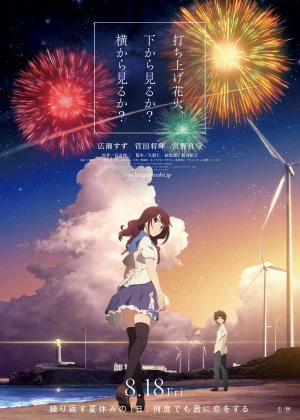Fireworks, Should We See It from the Side or the Bottom?
Movie details

Some films simply drift in seemingly out of nowhere, others come with a lot of baggage. The latter can often make it much harder to appreciate a film for what it actually is. When I read up on Akiyuki Shinbo and Nobuyuki Takeuchi's Fireworks, Should We See It from the Side or the Bottom? [Uchiage Hanabi, Shita Kara Miru ka? Yoko Kara Miru Ka?] this became painfully clear. Before watching this one, either make sure you know as little as possible about it, or at least get your expectations straight. If you can manage that, this film is a lovely surprise waiting to be discovered.
![screen capture of Fireworks, Should We See It from the Side or the Bottom? [Uchiage hanabi, shita kara miru ka? Yoko kara miru ka?]](/thumbs/style/site/1200xauto/fireworks-side-bottom-1.webp)
One way to look at Fireworks is as the follow-up to Makoto Shinkai's Your Name. Both films share a producer (Genki Kawamura), genre classification, broad plot outline and were released exactly one year apart. Another way to look at Fireworks is as the loose remake of Shunji Iwai's '93 TV film, one of the first signature breakthroughs for said director. Both angles are factually correct, but as far as setting expectations goes, this information is sure to push you in the wrong direction. Just forget about all of that and let's start fresh.
Sure, you're going to feel flashes of Shinkai in there, mostly in the film's summery vibe and its idyllic setting. And if you're already familiar with Iwai's film, you'll recognize many of the plot points, especially during the first half. But really, Fireworks, Should We See It from the Side or the Bottom? is a Shaft/Shinbo project first and foremost. The studio's trademark style stands perpendicular to Iwai's and Shinkai's approaches as it foregoes subtlety and tranquility, instead offering some sort of exaggerated celebration of quintessential anime themes and elements. Like or dislike it as you may, but that's what this film is, not some forced attempt to recreate Shinkai or Iwai.
A group of young boys and their summer quest to figure out whether fireworks are flat or round provide the framework for the film. But the core of Fireworks revolves around Norimichi's attempts to spend more time with his classmate Nazuna, a young girl on the verge of moving out of town. A peculiar sphere-like object helps Norimichi along whenever he falters, as it allows him to travel back in time and reverse decisions he made before, progressively steering him closer to spending his time with Nazuna.
![screen capture of Fireworks, Should We See It from the Side or the Bottom? [Uchiage hanabi, shita kara miru ka? Yoko kara miru ka?]](/thumbs/style/site/1200xauto/fireworks-side-bottom-2.webp)
If you're not familiar with Shaft's peculiar visual style, you might be taken aback by the somewhat harsh combination of CG and traditional anime cell styles. It's actually quite timid if you compare it to some of Shinbo's earlier work (Kizumonogatari I, II and III), but for those who stepped in hoping they were going to see the next Shinkai film, it may be somewhat of a shock. It's not just the CG though, it's the rapid editing, the exteme close-ups, the exaggerated angles and animation, the ever-changing visual fidelity and the fluid switching between different visual styles that make their work stand out. The core of Shaft's visual style draws from all the popular anime clichés, but the result is still something very unique and recognizable.
The soundtrack is probably the element that resembles the work of Iwai and Shinkai the most, which is another thing that may be a little problematic for Western audiences. While I'm sure that the blue skies and green fields accompanied by soft piano melodies will prove no hurdle for most, the explicit J-Pop songs on the soundtrack probably will. Shinkai and Iwai may have already paved the way a little, but it's still a hard sell to most film fans. Can't say I'm a huge fan myself, but I'm not put off by it either. The voice acting on the other hard is uniformly strong. Shinbo and Takeuchi go for a more natural approach, which really helps out the impact of the drama. This is crucial during the second half of the film, when the fantasy elements start going overboard and there's a real chance of losing track of the characters within the plot. Luckily, the two remain firmly at the center of the film, despite all the things going on around them and a lot of that is due to the excellent voice work of Suzu Hirose and Masaki Suda.
![screen capture of Fireworks, Should We See It from the Side or the Bottom? [Uchiage hanabi, shita kara miru ka? Yoko kara miru ka?]](/thumbs/style/site/1200xauto/fireworks-side-bottom-3.webp)
The first half of the film is pretty simple and straight-forward, the second half goes full Akira, only within a fantastical/dramatic setting. It's somewhat of a switch and again, if you're expecting Iwai and/or Shinkai material it might rub you the wrong way, but people actually used to watching anime won't be too shaken by the direction this films takes. In fact, it felt like a real accomplishment that Shinbo and Takeuchi managed to keep everything quite small and personal while still being grand and exuberant at the same time.
Fireworks, Should We See It from the Side or the Bottom? is an accomplished remake. It references the original material without outright copying it, it builds upon the original while also making sure the directors are allowed to make the material their own. The animation is abundant and on point, the voice acting is superb and the plot balances small human drama and wild fantasy perfectly. Shaft is quickly turning into one of the better anime studios around, though their strong roots may alienate less initiated viewers.